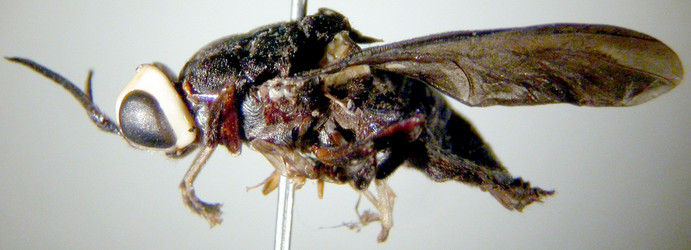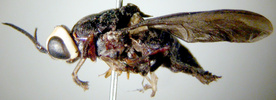Cyphomyia
Keith Bayless- Cyphomyia abana
- Cyphomyia acuminata
- Cyphomyia aczeli
- Cyphomyia affinis
- Cyphomyia albicaput
- Cyphomyia albispina
- Cyphomyia albitarsis
- Cyphomyia albomaculata
- Cyphomyia altifrons
- Cyphomyia androgyna
- Cyphomyia auriflamma
- Cyphomyia aurifrons
- Cyphomyia banksi
- Cyphomyia bicarinata
- Cyphomyia brevis
- Cyphomyia chalybea
- Cyphomyia chinensis
- Cyphomyia chrysodota
- Cyphomyia claripennis
- Cyphomyia coprates
- Cyphomyia curvispina
- Cyphomyia cyanea
- Cyphomyia dispar
- Cyphomyia dominicana
- Cyphomyia ecuadorensis
- Cyphomyia erecta
- Cyphomyia erectispinis
- Cyphomyia fascipes
- Cyphomyia fassli
- Cyphomyia ferruginea
- Cyphomyia flaviceps
- Cyphomyia flavimana
- Cyphomyia flavipennis
- Cyphomyia formosa
- Cyphomyia geniculata
- Cyphomyia golbachi
- Cyphomyia gracilicornis
- Cyphomyia helvipennis
- Cyphomyia hybrida
- Cyphomyia imitans
- Cyphomyia indica
- Cyphomyia jamesi
- Cyphomyia lasiophthalma
- Cyphomyia leucocephala
- Cyphomyia longicornis
- Cyphomyia marginata
- Cyphomyia marshalli
- Cyphomyia neivai
- Cyphomyia nigripes
- Cyphomyia nigritarsis
- Cyphomyia notabilis
- Cyphomyia nubilipennis
- Cyphomyia obscura
- Cyphomyia obscuripalpis
- Cyphomyia ochracea
- Cyphomyia orientalis
- Cyphomyia ornata
- Cyphomyia picta
- Cyphomyia pilosissima
- Cyphomyia planifrons
- Cyphomyia pseudomaculata
- Cyphomyia pubiventris
- Cyphomyia pulchella
- Cyphomyia regularis
- Cyphomyia rubra
- Cyphomyia scalaris
- Cyphomyia schwarzi
- Cyphomyia shannoni
- Cyphomyia simplex
- Cyphomyia souzalopesi
- Cyphomyia speciosa
- Cyphomyia sulcifrons
- Cyphomyia tomentosa
- Cyphomyia unicolor
- Cyphomyia varipes
- Cyphomyia verticalis
- Cyphomyia violacea
- Cyphomyia whiteheadi
- Cyphomyia wiedemanni
- Cyphomyia willistoni
- Cyphomyia xanthobasis
- Cyphomyia ypsilon
- Cyphomyia zernyi
Introduction
Many species of Cyphomyia are large and colorful, and several have a distinctive habitus of a pure white, bare head with a blue body. Some species have been observed to hover in the fashion of flies in the family Syrphidae. The larvae, where known, live in decaying organic matter such as rotting cacti (Woodley 2001). Eight species of Cyphomyia are found in East Asia, one, C. pubiventris, is found in South Africa, one, C. marshalli, is found on the Solomon Islands, several species are found in the Southwestern U.S., and the rest are endemic to the Neotropical Region (Woodley 2001).
Characteristics
Cyphomyia is distinguished from other Nearctic Clitellariinae by the presence of crossvein m-cu, the large, apical scutellar spines, and the antennae not stylate in shape (James 1981).
References
James, M.T. 1981. 36. Stratiomyidae. Manual Nearct. Dipt. 1: 497-511.
Woodley, N. E. 2001. A World Catalog of the Stratiomyidae (Insecta: Diptera). Myia 11: 1-473. Backhuys Publishers, Leiden.
Information on the Internet
- Harvard MCZ Type Images. Images of Cyphomyia acuminata.
- Harvard MCZ Type Images. Images of Cyphomyia banksi.
- Harvard MCZ Type Images. Images of Cyphomyia brevis.
- Harvard MCZ Type Images. Images of Cyphomyia formosa.
- Harvard MCZ Type Images. Images of Cyphomyia marginata.
- Harvard MCZ Type Images. Images of Cyphomyia rubra.
- Harvard MCZ Type Images. Images of Cyphomyia simplex.
Title Illustrations

| Scientific Name | Cyphomyia sulcifrons |
|---|---|
| Location | Mexico; La Buena Ventura, Vera Cruz |
| Identified By | C. H. Curran |
| Sex | Female |
| Life Cycle Stage | Adult |
| View | lateral |
| Collection | American Museum of Natural History, New York |
| Source | Cyphomyia sulcifrons |
| Image Use |
 This media file is licensed under the Creative Commons Attribution-NonCommercial License - Version 2.5. This media file is licensed under the Creative Commons Attribution-NonCommercial License - Version 2.5.
|
| Copyright |
© Martin Hauser

|
About This Page
Keith Bayless

North Carolina State University, Raleigh, North Carolina, USA
Correspondence regarding this page should be directed to Keith Bayless at
Page copyright © 2008 Keith Bayless
All Rights Reserved.
- First online 28 September 2008
- Content changed 28 September 2008
Citing this page:
Bayless, Keith. 2008. Cyphomyia. Version 28 September 2008 (under construction). http://tolweb.org/Cyphomyia/108719/2008.09.28 in The Tree of Life Web Project, http://tolweb.org/








 Go to quick links
Go to quick search
Go to navigation for this section of the ToL site
Go to detailed links for the ToL site
Go to quick links
Go to quick search
Go to navigation for this section of the ToL site
Go to detailed links for the ToL site